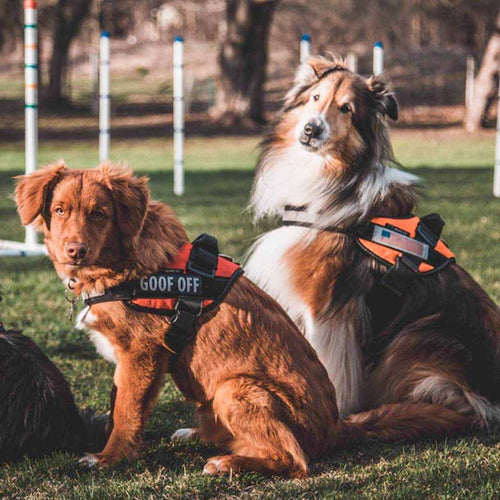Martingale collars, a timeless staple for Greyhound enthusiasts, have evolved into a must-have for pet parents across all canine companions. Recently, these collars have experienced an unprecedented surge in popularity. The martingale, a revolutionary collar design, ensures a leash experience that is both secure and humane, offering a delicate balance between safety and comfort, all without the risk of choking.
What Is a Martingale Collar?
A martingale collar looks similar to a flat collar but includes an additional loop of material, often made of fabric or chain, that forms a smaller loop within the larger collar.
Here is the component of a martingale dog collar:
-
The larger loop: It goes around your dog’s neck. This loop is also known as the "control loop."
-
The smaller loop: with a D-ring, upon which you attach the leash.
The larger loop is also known as the "control loop". It is a masterpiece of adjustability, and grants you the power to sculpt the perfect fit, ensuring a snug embrace over your pet's head and neck—no choking or slipping off on the horizon.
When the leash becomes a battleground of tugs and pulls, behold the dance of tension. The smaller loop, adorned with purpose and a D-ring, elegantly tightens, coaxing the larger loop into a gentle, uniform embrace around your dog's neck. It's a symphony of security and style.
And when your spirited pup decides to take a leash hiatus, the collar gracefully reverts to its original shape. This isn't just a collar; it's a dynamic entity that responds to your dog's every move.
Here's the magic: the loop tightens, not to inflict discomfort but to be the steadfast sentinel against slipouts. It's the Goldilocks of collars—just tight enough for security, never too tight to harm.
But there's more. This ingenious feature doubles as a training maestro. As the loop snugly communicates the art of restraint, your dog learns the grace of walking without the pull-and-tug theatrics. It's no wonder martingale dog collars are the secret weapons in the arsenal of dog trainers, recommended with fervor for their unique blend of form, function, and finesse.
A martingale collar is designed to provide gentle and controlled correction during walks, particularly for dogs that may have a tendency to slip out of traditional collars or pull on the leash.
Here's how a martingale collar works:
-
Prevention of Slipping: One of the primary purposes of a martingale dog collar is to prevent dogs, especially those with slim heads or necks like sighthounds, from easily slipping out of their collars. The design includes a smaller loop that tightens when tension is applied, ensuring the collar stays securely in place.
-
Controlled Tightening: When the dog pulls on the leash, the martingale collar tightens gradually. However, unlike choke collars, the tightening action is limited, preventing it from becoming too constrictive. This controlled tightening serves as a gentle reminder to the dog, discouraging pulling behavior.
-
Training Aid: Martingale collars can be effective training aids for dogs learning to walk on a leash. The controlled tightening of the collar provides a cue to the dog that pulling is not desirable. As the dog learns to walk without pulling, the collar automatically loosens.
-
Comfortable and Secure Fit: The martingale collar is designed to provide a snug but comfortable fit. It allows for a secure grip on the dog's neck without the risk of over-tightening. The collar should be properly fitted so that it stays in place without causing discomfort or restricting the dog's breathing.
-
Versatility: Martingale collars come in different styles, including those with buckles for easy on-and-off and slip-on designs. This versatility allows dog owners to choose the type that best suits their preferences and their dog's needs.
It's important to note that while martingale collars can be effective tools for training and control, they should be used responsibly. Regular checks for proper fit, sizing, and the dog's comfort are essential. Additionally, martingale collars are intended for use during walks and training sessions and should not be left on unattended dogs.
Martingale Collars vs. Other Collar Types
Let's delve into the world of canine neckwear and decipher the nuances between a flat collar, a choke collar, a prong collar and the innovative martingale.
Flat Collar
First up, the classic flat collar—a straightforward, no-nonsense accessory that snugly wraps around your dog's neck. It's the everyday choice, ideal for holding tags and connecting a leash during casual strolls. Reliable, yes, but when it comes to control, it has its limitations.
Choke Collar
Now, let's talk choke collar. Picture a chain-link design that tightens around your dog's neck when tension is applied to the leash. While it may offer control, it comes with risks and concerns. The potential for discomfort and injury is real, making it a less-than-ideal choice for many conscientious dog owners.
Prong Collar
Enter the prong collar, a more assertive contender. Also known as a pinch collar, it has a series of metal links with prongs that, when tension is applied, gently squeeze the dog's neck. It might sound a bit intense, but the idea is to mimic the way a mother dog corrects her pups. Used properly, it's less about causing discomfort and more about communicating.
Martingale Collar
At first glance, it mirrors the flat collar but conceals a strategic smaller loop, often crafted from durable fabric or chain, with a D-ring attached. The magic happens when your pup decides to test their leash-pulling skills. The martingale steps in with a gentle, controlled response. Tension on the leash triggers the smaller loop to tighten, coaxing the larger loop into a snug fit around your dog's neck. The beauty of it? It's a Goldilocks scenario—not too tight, not too loose. It provides the control you need without compromising your dog's comfort or safety.
In essence, while the flat collar is the standard, the choke collar and the prong collar raise concerns, and the martingale emerges as the smart choice—a blend of style, comfort, and effective control.
Should I Get a Martingale Collar for My Dog?
For dog owners, the nightmare of their furry friend slipping away during a walk is all too real. The joy of a leisurely stroll can quickly sour when your pup manages to wriggle out of their collar. But fear not, there's a solution that not only prevents such escapes but elevates your dog-walking game—the martingale collar.
Here's why the martingale dog collar is the ultimate choice for you and your pup:
-
Escape-Proof Design
Some dog breeds, especially sighthounds, have a knack for slipping out of traditional collars. Factors like fur texture can further complicate matters. Enter the martingale design—it's the ultimate escape deterrent. Regardless of your dog's head shape, neck size, or fur texture, the martingale makes slipping free a challenging feat.
-
Training Made Easy
If your dog is still mastering the art of leash walking, pulling and tugging can be par for the course. This behavior not only risks choking but can lead to serious injuries, especially with the wrong walking gear. Martingale collars act as invaluable training aids. The adjustable loop tightens proportionally to your pup's size, ensuring it never reaches a choking point. When the pulling stops, it gracefully reverts to its original diameter, teaching your furry companion the ropes of good leash behavior.
-
Gentle on Your Pup
Martingale collars wear the badge of humanity. You have control over setting a length beyond which they won't constrict. When tension kicks in, the even constriction distributes pressure, preventing any choking or injury. What's more, these collars offer customization for a snug fit, allowing you to make slight adjustments tailored to your pet's comfort.
In essence, the martingale collar isn't just a leash accessory—it's a guardian against escapes, a mentor in leash etiquette, and a symbol of humane control. Make the switch, and transform your walks into worry-free adventures with your furry sidekick.
How to Fit a Martingale Collar for Your Dog Properly?
Ensuring your dog's martingale collar fits just right is not just about style—it's about safety and comfort. Here's your step-by-step guide on how to properly fit a martingale dog collar for your furry companion:
-
Measure with Precision
When it comes to martingale collars, size matters—a snug fit ensures both comfort and effectiveness. A rule of thumb: the collar should be tight enough to prevent slipping, yet loose enough to allow comfortable breathing and movement.
For a Buckled Martingale Collar
Using the soft a measuring tape, encircle your dog's neck where their collar would gracefully reside. Let the tape snugly embrace, but not imprison. Jot down this measurement, and then select the size that aligns closely with your dog's exact neck size—while also contemplating the future. Imagine a puppy with a neck size of 13", yet faced with the alluring choices of 12" and 14". In this scenario, we advocate sizing up to 14", leaving room for growth and future adventures.
For Slip-on Martingale Collar
Now, if you're opting for the sleek simplicity of a slip-on martingale collar, the measuring saga takes an extra turn. Enlist the measuring tape to trace the circumference of your dog's head—from the majestic throat summit, over the ears, to the pinnacle of their head.
-
Consider Growth
If you have a puppy or a dog that's still growing, factor in potential size changes. Opting for a slightly larger size allows room for growth, ensuring the collar remains a perfect fit as your pup matures.
-
Choose the Right Size
Refer to the sizing chart provided by the manufacturer. Select the martingale size that aligns with your measured neck circumference. When in doubt, go for the larger size to prevent any discomfort.
-
Slip-On or Buckled Martingale
Determine whether you prefer a slip-on martingale or one with a buckle. Slip-on versions are convenient but require precise sizing, while buckled martingales offer more adjustability. If you choose a buckled martingale, follow the manufacturer's instructions for securing the buckle.
-
Test the Fit
Once the martingale is on your dog, it's time for the fit test. Ensure that it rests high on the neck, just behind the ears. You should be able to fit two fingers comfortably between the collar and your dog's neck. This ensures a snug yet not constricting fit.
-
Observe Movement
Watch how the martingale collar moves as your dog walks. It should stay snug when there's tension on the leash but relax when the leash is loose. The martingale should neither chafe nor impede your dog's natural movements.
Properly fitting a martingale collar is an investment in your dog's well-being and your peace of mind during walks. Take the time to ensure a snug, secure, and comfortable fit, and you'll be ready for stylish and safe adventures with your furry friend!
How to Use A Martingale Collar Safely?
Step into the realm of martingale collars, a safer alternative to the ordinary, but not without its nuances. To navigate the fine line of safety and style, adopt these indispensable practices for a harmonious experience with your pup:
-
Tailored Perfection: Choose a martingale dog collar that cradles your dog's neck just right—too tight risks choking, too loose invites slippery escapades.
-
Familiar Introduction: Introduce the martingale collar in a familiar haven, letting your pup acclimate before embarking on a walk.
-
Supervision is Key: Never leave your dog alone adorned with a martingale. It's a potential snag hazard, threatening to ensnare on household items and surfaces, posing a risk of choking.
-
Leash Harmony: The synergy between martingale collars and leashes is paramount. Without a leash, there's a risk of the collar loosening enough for your dog to slip free.
-
No Kennel Collaring: Save the collar for moments beyond the kennel walls. Putting it on inside the crate can lead to unforeseen entanglements.
Martingale collars aren't just a solution; they're the epitome of walking and training sophistication. Embrace security and comfort that ensures impeccable behavior without compromising your dog's well-being. Bid farewell to leash-related chaos, as these collars gracefully discourage pulling and tugging, promising walks that are a delight for both you and your furry companion.
Frequently Asked Questions
-
Are Martingale Collars Cruel?
No, Martingale collars are not inherently cruel when used correctly. In fact, they are designed to be a humane and effective tool for certain situations. Martingale collars are particularly useful for dogs that may slip out of traditional collars or for dogs that tend to pull on the leash.
The key to using a Martingale collar humanely is proper fitting and responsible use. The collar should be adjusted to fit loosely around the dog's neck when not engaged, allowing for comfort. When the leash is pulled, the collar gently tightens to prevent slipping out without choking or causing harm to the trachea.
Like any tool, it's important to use Martingale collars responsibly and under proper guidance. If unsure, consulting with a professional dog trainer or veterinarian can ensure that the collar is suitable for your dog's specific needs and that it is being used in a humane manner.
-
What is the Difference between a Martingale Collar and a Slip Lead?
A martingale collar is designed to prevent a dog from slipping out of their collar. It consists of a length of material with a metal ring at each end. The collar tightens when the dog pulls, but it doesn't choke the dog completely. This type of collar is often used for dogs with narrower heads, like Greyhounds, to prevent them from easily slipping out of a traditional collar.
On the other hand, a
slip lead is a leash and collar in one. It's a loop of material that tightens around the dog's neck when you pull on it. Slip leads are commonly used in training and are often used by dog handlers or trainers because they can be quickly and easily put on and taken off. They're not ideal for all dogs, especially those that may pull a lot, as they can tighten quite a bit.
In summary, while both collars involve some tightening action, a martingale collar is more of a traditional collar with a limited tightening function to prevent escape, while a slip lead is a combination of a collar and leash, commonly used in training scenarios.
-
Is a Martingale Collar Better than a Harness?
The choice between a martingale collar and a harness depends on various factors, including the specific needs and preferences of both you and your dog. Each has its advantages, and what might be "better" often comes down to your individual circumstances. Here's a breakdown to help you decide:
Martingale Collar
|
Pros
|
Cons
|
-
Control: Martingale collars provide effective control, especially for dogs that tend to pull on the leash.
-
Prevents Slipping: Ideal for dogs with slender heads, as it helps prevent them from slipping out.
-
Training Aid: Can be used as a training aid for discouraging pulling behavior.
|
Neck Strain: Continuous pulling on the collar can potentially cause strain on the neck, especially for dogs that are prone to pulling.
|
Harness
|
Pros
|
Cons
|
-
Distribution of Pressure: Harnesses distribute pressure more evenly across the body, reducing the risk of neck strain.
-
Security: Offers greater security, as it's more difficult for dogs to slip out of a properly fitted harness.
-
Ideal for Certain Health Conditions: Suitable for dogs with respiratory or tracheal issues, as it minimizes pressure on the neck.
|
-
Training Challenges: Some dogs may initially find harnesses unfamiliar and might require time to get used to them.
-
Potential for Pulling: While harnesses can discourage pulling, they might not be as effective as martingale collars in providing immediate feedback during training.
|
Considerations
-
Behavior and Training Needs: If your dog is still in training or has a tendency to pull, a martingale collar might be more suitable. If you want to distribute pressure more evenly or if your dog has specific health concerns, a harness might be a better choice.
-
Dog's Comfort: Some dogs are more comfortable in harnesses, especially those prone to respiratory issues. Others might prefer the feeling of a collar.
-
Safety: Both options can be safe when used correctly. Ensure that whichever you choose is properly fitted and regularly checked for any signs of wear.
Ultimately, there's no one-size-fits-all answer. It's worth trying both options and observing how your dog responds to determine which provides the best combination of control, comfort, and safety for your specific situation.
-
What Breeds Need Martingale Collars?
Martingale collars, often dubbed as "greyhound collars," aren't just tailored for slender-headed breeds like Greyhounds, Whippets, and Salukis. While they're the go-to choice for those with svelte noggins, these collars extend their prowess beyond the world of sighthounds.
Picture this: a versatile accessory that transcends breed boundaries. Martingale collars are the secret weapon for any dog with a knack for slipping out of conventional collars. They're the ally for pet owners seeking a touch more control on the leash without compromising their furball's well-being.
But wait, there's more to the martingale magic! Imagine rescue groups adopting martingales as the ultimate "back-up collars." Paired alongside flat collars, these marvels add an extra layer of security during walks, ensuring that every canine adventure is not just stylish but also safe.
So, whether your dog is a sighthound sensation or a spirited escape artist, the martingale collar emerges as the hero of the leash, promising style, control, and security in one chic package. Step into a world where every walk is an adventure, backed by the reliability of a martingale collar.
-
Can a Dog Wear a Martingale Dog Collar All Day?
While martingale dog collars are designed for use during walks and training sessions, it's generally not recommended for a dog to wear a martingale dog collar all day. Here are a few considerations:
-
Comfort: Martingale dog collars are intended for controlled tightening during leash tension. Wearing the collar continuously may cause discomfort for the dog, especially if the collar is consistently snug.
-
Safety Concerns: Leaving any collar on a dog unattended can pose safety concerns. The design of the martingale dog collar includes a smaller loop that tightens, and there is a risk of it getting caught on objects, leading to potential injury or strangulation.
-
Supervision: Dogs should be supervised while wearing any type of collar to ensure that it remains properly fitted and doesn't cause any discomfort. Regular checks for fit, condition, and any signs of irritation are crucial.
-
Interactions with Other Dogs: If dogs are playing together, collars can get caught on each other, leading to potential accidents or injuries.
If you need your dog to wear identification at all times, consider using a flat collar with a breakaway feature that releases under pressure, reducing the risk of injury.
It's important to follow the guidelines provided by the manufacturer of the martingale dog collar you choose. Always prioritize the safety and well-being of your dog, and consult with your veterinarian for personalized advice based on your dog's individual needs and behavior.































